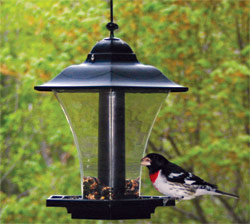I'm a random, somewhat lazy twitcher. That's British for bird watcher, Marilyn Westphal of the Elisha Mitchell Audubon Society told me many years ago (see "In Search of the Yellow-Bellied Sapsucker," March 11, 1998, Xpress). These days, however, the North Carolina Birding Trail has piqued my interest in all things avian: The Western North Carolina segment has just been completed, some three years after the coastal section debuted. But it's not like the AT or the Mountains-to-Sea Trail; it's more a driving route linking premier birding places. From the Outer Banks to Craggy Gardens, the route strings together 310 sites where dedicated twitchers may spot everything from tundra swans to the warbling vireo (which I like to confuse with a Tennessee warbler).

I've yet to see either a vireo or a warbler, though the vireo and several warbler species frequent the Beaver Lake Bird Sanctuary in spring. And that's just it: My viewings seem to come at odd times, and for the most part, they hinge on what I can spy from my living-room chair.
This winter, dark-eyed juncos hopped in the snow and darted about my porch in search of birdseed. I've long had a soft spot for these sparrow-size creatures, which puff up like dark, fuzzy balls when the cold winds blow. And there are times when the males entertain me by jockeying for access to the feeder.
Once, while they were so engaged, a titmouse flitted over to the sock full of nuts and berries that dangles under the eaves. A slender gray bird with a ruffled crest, he looked left and right, eyeballed the testy juncos, then pecked out a single nut and flew off. A short while later, he returned for another treat, clinging to the sock but quick to dart away if I so much as breathed.
This little routine went on for weeks till, one day, the shy titmouse stuck around long enough to feed and pose for pictures.
But alas, a bird at least twice his size barreled down to the feeding tray, flapping his wings to steady himself. The feeder tossed like a ship in a storm, and I snapped shot after shot, almost all out of focus till the final frame. In the shadow of the eaves, a rose-breasted grosbeak had landed.
I'd previously seen them only in books, yet here it was. And then it flew off.
A few weeks later, around midnight, a late-season snow blew across the ridge like a miniblizzard, and I heard a thump on the tin roof. Then another. Grabbing a flashlight, I ventured out into the blowing snow. Something large and ghostly white flew overhead. There was another thump on the roof and a tenor flutter of wings, some squeaks and a crackling of small tree limbs. Two ring-billed seagulls — tossed off course by a Carolina snowstorm — had just made a forced landing near the Appalachian Trail. They seemed almost drunk, or perhaps merely bone-weary, dropping to earth like weighted paper bags. They nestled in the snow till the storm ended and then resumed their journey.
My avian adventures have included a glimpse of an indigo bunting here, the invasion of the pine siskins there, the thistle-loving golden bullfinches, and even the buzz of a ruby-throated hummingbird trapped in my living room (I donned a glove, caught him and released him safely outside). But the sightings typically hit a summer lull, with just a cardinal or two dropping by.
Now, however, the birding trail entices me with tales of peregrine falcons, yellow-billed cuckoos and, of course, those elusive vireos and warblers. There are 105 sites in the mountain counties, including Grandfather Mountain (Avery), Max Patch (Haywood), Mingo Falls (Swain) and the aptly named Whippoorwill Academy and Village (Wilkes).
In Buncombe, the trail connects Beaver Lake, Bull Creek, Craggy Gardens, The North Carolina Arboretum, Charles D. Owen Park, the Biltmore Estate, the French Broad River Greenway, the Sandy Mush Game Land and the Black Mountains. According to the N.C. Wildlife Resources Commission, the trail encourages nature-based tourism, which promotes wildlife conservation while supporting local economies. (Americans spent about $45 billion in bird-related retail sales in 2006, the commission notes). A handy book, The North Carolina Birding Trail: Mountain Trail Guide, details every site with maps, directions, lists of birds one is likely to spot and notes on other nearby natural and cultural features. And through Sunday, Aug. 2, the arboretum is also hosting a display of rustic bird houses.
All that activity just might be enough to pry me out of my chair and inspire me to grab my dad's old binoculars and head out in search of those ever-melodic warblers and vireos.
To learn more about the bird-house show, go to www.ncarboretum.org. For more on the bird trail, visit www.ncbirdingtrail.org.
Send your outdoors news to mvwilliams@mountainx.com, or call 251-1333, ext. 152.
Two ring-billed seagulls — tossed off course by a Carolina snowstorm — had just made a forced landing near the Appalachian Trail.



Before you comment
The comments section is here to provide a platform for civil dialogue on the issues we face together as a local community. Xpress is committed to offering this platform for all voices, but when the tone of the discussion gets nasty or strays off topic, we believe many people choose not to participate. Xpress editors are determined to moderate comments to ensure a constructive interchange is maintained. All comments judged not to be in keeping with the spirit of civil discourse will be removed and repeat violators will be banned. See here for our terms of service. Thank you for being part of this effort to promote respectful discussion.